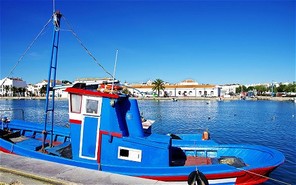
Layers of history can be seen, from Phoenician excavations through Islamic-decorated doorways to Renaissance and Baroque flourishes. However, it is the colours that hit you: blinding-white walls, brilliant azulejo tiles, fiery-red pantiles.
I climbed cobbled streets to the ramparts of the ruined Castelo and looked down over waves of triangular “hipped” roofs, spikes of lacework-white chimney pots, and the graceful domes and towers of the town’s 22 churches. The river sprawled into the Ria Formosa lagoon, a rich nature reserve bordered by an eight-mile-long string of golden sands.
Praça da República
Rebuilt in the 13th century, after the town was recaptured from the Moors, the Castelo was partially destroyed in the 1755 earthquake. Today, a beautiful garden sits amid the crumbling walls, ablaze with oleander, jacaranda, angel’s trumpets and bougainvillea.
Close to the Castelo, the 16th-century Palácio da Galeria (now a gallery), with Baroque window mouldings and 16 roofs, is a vestige of Tavira’s wealthy past. Once the Algarve’s main port, the town saw its fortunes change after the earthquake hit and the river silted up, although fishing and salt extraction are still important.
From the Palácio, I explored churches: the Gothic portico of Santa Maria and its huge clock-face tower; the austere façade of the late-medieval São Brás; elaborately carved wooden altarpieces in São Paulo; tiny, medieval Santa Ana with its pretty bell-tower and lovely river views. Most spectacular is the Renaissance Misericórdia, with its carved portico and shimmering blue-and-white tiled panels depicting the 14 Acts of Mercy.
Tavira was once the Algarve’s main port
Exploring Tavira can be slow. Something always drags you off course: latticework doors with door knockers in the shape of hands (a Moorish legacy); brilliant azulejo tiling (Rua Almirante Cândido dos Reis is a treat); coffee, cake and people-watching in the riverside Praça da República; sleepy squares such as Largo d’Anna with its shady Cape Lilac trees and inviting benches.
I slipped in to the Carmo Convent church as it filled up for evening mass. A priest led the congregation in a choral warm-up, his sonorous voice filling the nave beneath a magnificently overblown Rococo altarpiece.
On my final morning, I strolled through the riverside Bandstand Garden, listening to elderly men putting the world to rights, peered at fish from the low-arched Ponte Romana (late-medieval, in truth), and watched a bronzed fisherman sift for clams. The 21st century seemed a long way away.
EssentialsGETTING THERE
Airlines flying to Faro from London and regional airports include British Airways (0844 493 0787; ba.com), EasyJet (0843 104 5000;easyjet.com), Flybe (0871 700 2000; flybe.com), Jet2 (0871 226 1737;jet2.com), Monarch (0871 940 5040; monarch.co.uk), Ryanair (0871 246 0000; ryanair.com), Thomas Cook (0871 230 2406; flythomascook.com) and Thomson (0871 231 4787; thomsonfly.com). The 20-minute shuttle bus into Faro costs €1.70/£1.40, and from there it is an hour’s bus ride (€4.20/£3.45) to Tavira. Auto-Rent (0800 032 4979; autorent.pt) has three-day car hire from £20 during winter (£65, summer).
GETTING AROUND
The Old Town is easily walkable. To go farther afield, hire a bicycle from Casa Abilio, on Rua João Vaz Corte Real 23A (00351 281 323467;abiliobikes.com, from €6/£4.95 one day, €16.5€/£13.60, three days). A return by ferry to the beach costs €1.90/£1.55 from the town centre (summer only) or €1.50/£1.25 from Quatro Águas, the nearer lagoon.
INSIDE TRACK
Most churches, Misericórdia aside, are closed except for services or concerts. Visit half an hour before Mass, or check at the tourist office (281 322511; visitalgarve.pt, Praça da República 5) for information on concerts.
INSIDE TRACK
Café Veneza and Pastelaria Tavira Romana, in Praça da República, are good places in which to try local cakes such as pastel de nata (egg tart) or morgado da serra (almond cake) and to watch the passing show.
Explore the Ria Formosa lagoon by boat (918 720002; formosamar.com, €15 per person, one-hour guided tour), passing salt-pans, clam and oyster farms, and spotting birds such as flamingos and egrets.
Round off an evening with home-made ice cream at Delizia, in Mercado da Ribeira, the old covered market. By Helen Pickles

 RSS Feed
RSS Feed
